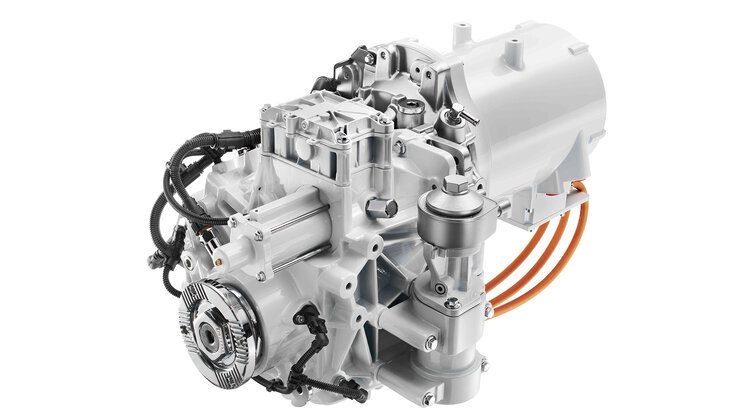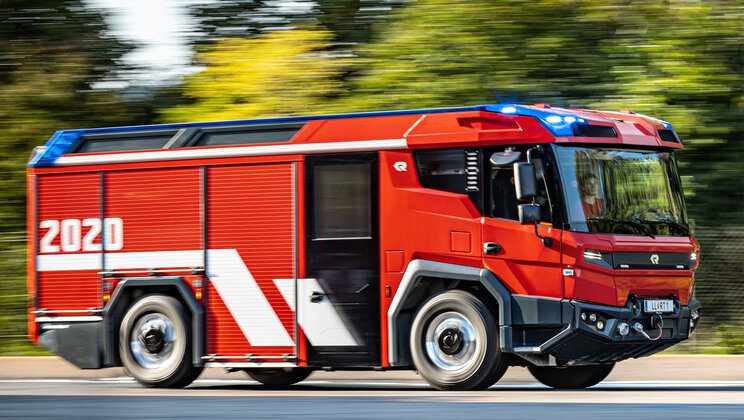Volvo Penta, a subsidiary of Swedish automotive megalith Volvo Group, announced this week that three fire trucks featuring its electric drivelines had been shipped by manufacturer Rosenbauer to fire departments in Berlin, Amsterdam, and Dubai to begin real-world customer testing.
Rosenbauer’s “Revolutionary Technology” (RT) fire trucks have been in development for three years as the first hybrid tank firefighting vehicles.
Rosenbauer explains that these fire trucks “are far ahead of modern standard vehicles in terms of their operational tactical benefits, loading options and firefighting equipment, and are revolutionary in every respect.”
According to Volvo Penta, the new electric driveline at the heart of the RT “boasts excellent ergonomics, functionality, and safety, as well as high loading volumes, compact dimensions and one-of-a-kind agility” in addition to zero exhaust emissions and significantly reduced noise levels.
Unveiled earlier this year as a “game-changer” for fire trucks, Volvo Penta boasted that the “completely new vehicle architecture” would revolutionize the fire service industry.
“We are extremely proud to collaborate with our longstanding customer Rosenbauer and help create the most revolutionary and progressive vehicle in the fire service industry,” said Paul Jansson, Chief Project Manager at Volvo Penta.
“Our two teams worked closely together during the development process and the result is an industry-leading truck that will help fire departments around the world improve safety and functionality, as well as reduce emissions and fuel costs.”

“Volvo Penta’s electric driveline uses proven Volvo Group technology which has been tailored to meet the performance requirements of a fire service application.”
The Volvo Penta-powered RT features two electric motors that can provide up to 360kW (490 HP) and up to 50,000Nm for all wheels. Equipped with one, or optionally two, high-voltage batteries, each with a capacity of 50kWh, as well as a six-cylinder diesel engine with an output of 200kW (272HP) and a power generator.
According to Rosenbauer, shorter firefighting operations can be accomplished with the 100kWh model, but for longer operations the 50kWh with diesel engine is likely necessary.
Several external devices – such as fans or submersible pumps – with a total power consumption of up to 18kW can be operated simultaneously via the power outlet, and the extinguishing water pump can be operated either electrically by means of a generator or by the range extender (diesel engine).
Charging of the RT’s batteries can be done through either a standard AC industrial power socket or using DC charging stations. With a full charging capacity of 150kW, Rosenbauer claims that only 15 minutes is necessary to charge both batteries from 50% to 80%.
“The RT is in a different league to modern standard firefighting vehicles in terms of its operational tactical benefits, loading options and firefighting equipment,” says Dieter Siegel, CEO at Rosenbauer International.
“Volvo Penta already supplied us with diesel engines for our conventional fire trucks. After many years of successful collaboration – coupled with the fact that they are part of the Volvo Group which is leading the way when it comes to electromobility and electric trucks – they were the ideal partner for the RT project.
“We’ve worked together closely to design a tailored solution, using proven Volvo technology, that enables our electric fire truck to do its job in a safer, more effective and more sustainable way than a conventional vehicle.”
Joshua S. Hill is a Melbourne-based journalist who has been writing about climate change, clean technology, and electric vehicles for over 15 years. He has been reporting on electric vehicles and clean technologies for Renew Economy and The Driven since 2012. His preferred mode of transport is his feet.

